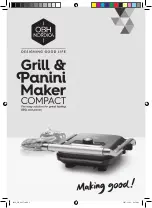
2
For your safety and the safety of others, read and under-
stand the safety recommendations and operating instruc-
tions before operating a drill.
Always wear protective equipment:
For additional information on eye protection and face
protection, refer to Federal OSHA Regulations, 29 Code
of Federal Regulations, Section 1910.133., Eye and Face
Protection, and American National Standards Institute,
ANSI Z87.1, Occupational and Educational Eye and Face
Protection. Z87.1 is available from the American National
Standards Institute, Inc., 11 West 42nd Street, New York,
NY 10036.
Hearing protection is recommended in high noise areas
85 dBA or greater. The operation of other tools and
equipment in the area, reflective surfaces, process noises
and resonant structures can substantially contribute to,
and increase the noise level in the area. Excessive air
pressure above 90 PSIG or worn motor components can
also increase sound level emitted by tool. Proper hearing
conservation measures, including annual audiograms
and training in the use and fit of hearing protection devices
may be necessary. For additional information on hearing
protection, refer to Federal Regulations, Section 1910.95,
Occupational Noise Exposure, and American National
Standards Institute, ANSI S12.6, Hearing Protectors.
Drilling operations may produce hazardous fumes and/or
dust. To avoid adverse health effects utilize adequate
Safety Recommendations
WARNING
!
Wear respirator where
necessary.
!
Do not wear loose fitting clothes,
long hair, gloves, ties or jewelry.
WARNING
CAUTION
!
Personal hearing protection is
recommended when operating
or working near this tool.
WARNING
!
Impact resistant eye protection
must be worn while operating
or working near this tool.
CAUTION
!
ventilation and/or wear a respirator. Respirators should be
selected, fitted, used and maintained in accordance with
Occupational Safety and Health Administration and other
applicable regulations. Read the material safety data
sheet of any cutting fluids or materials involved in the
drilling process.
Follow good ma-
chine shop practices.
Rotating shafts and
moving components
can entangle and en-
trap, and can result
in serious injuries.
Never wear long hair,
loose-fitting clothes,
gloves, ties, or jew-
elry when working
with or near a drill of
any type.
Cleco drills are designed to operate on 90 psig (6.2 bar)
maximum air pressure. If the tool is properly sized and
applied, higher air pressure is unnecessary. Excessive air
pressure increases the loads and stresses on the tool
parts and may result in breakage. Installation of a filter-
regulator-lubricator in the air supply line ahead of the tool
is recommended.
Before the tool is connected to the air supply, check the
throttle for proper operation (i. e., throttle moves freely and
returns to closed position). Being careful not to endanger
adjacent personnel, clear the air hose of accumulated
dust and moisture. Before removing a tool from service or
changing a drill bit, tap, reamer, or any accessory make
sure the air line is shut off and drained of air. This will
prevent the tool from operating if the throttle is accidently
engaged.
Sudden and high reaction torque may
be experienced with any drill if:
• drill motor stalls by excessive load being applied to drill
bit or drill bit snags on material being drilled.
• on break-through when the drill bit passes through the
material being drilled. User must be prepared to resist
torque.
Содержание 8DL Series
Страница 14: ...14 NOTES...
Страница 15: ...15 NOTES...


































